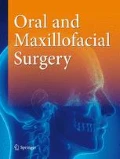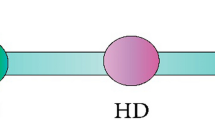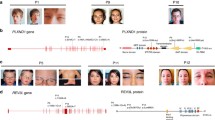Abstract
Objectives
The molecular underpinnings of Moebius syndrome (MBS) are diverse. This article provides a comprehensive summation of the genetic and etiologic literature underlying this disorder. Elucidating the genetic causes of the disorder can aid in earlier detection and treatment planning.
Design
Articles from 1880–2013 were selected and reviewed by six researchers to understand all of the molecular theories and chronicity of advancements in the literature.
Results
Mutations in the MBS1, MBS2, and MBS3 gene loci all have contributed to the development of MBS through various pathways. HOX family genes coding for homeobox domains, also, have been implicated in the abnormal development of the human brain. These are among the numerous genes that have been linked to the development of MBS.
Conclusion
Our study codified nascent findings of the molecular determinants of MBS. These findings add to a growing database of MBS-associated mutations and can be used to diagnose MBS and clarify pathogenesis.
Similar content being viewed by others
References
Von Graefe A In: von Graefe A, Saemisch T (eds) Handbuch der Gesamten Augenheilkunde (Handbook of Opthalmology). Vol 6. W Engelmann, Leipzig, 1880:60–67.
Möbius PJ (1888) Ueber angeborene doppelseitige Abducens-Facialis-Lahmung. Munch Med Wochenschr 35(6):91–94
Lindsay RW, Hadlock TA, Cheney ML (2010) Upper lip elongation in Möbius syndrome. Otolaryngol Head Neck Surg 142:286–287
Kulkarni A, Madhavi MR, Nagasudha M, Bhavi G (2012) A rare case of Moebius sequence. Indian J Ophthalmol 60(6):558–560
Shashikiran ND, Subba Reddy VV, Patil R (2004) “Moebius syndrome”. A case report. J Indian Soc Pedod Prev Dent 22(3):96–99
Terzis JK, Noah EM (2002) Möbius and Möbius-like patients: etiology, diagnosis, and treatment options. Clin Plast Surg 29:497–514
Verzijl HT, Valk J, de Vries R, Padberg GW (2005) Radiological evidence for absence of the facial nerve in Möbius syndrome. Neurology 64:849–855
Verzijl HT, van der Zwaag B, Cruysber JRM, Padberg GW (2003) Möbius syndrome redefined: a syndrome of rhombencephalic maldevelopment. Neurology 61:327–333
Suvarna J, Bagnawar M, Deshmukh CT (2006) Moebius syndrome with total anomalous pulmonary venous connection. Indian J Pediatr 73:53–55
Caravella R, Rogers GL (1978) Dextrocardia and ventricular septal defect in the Möbius syndrome. Ann Ophthalmol 10(5):572–575
Raroque HG, Hershewe GL, Snyder RD (1988) Möbius syndrome and transposition of the great vessels. Neurology 38:1894–1895
Deda G, Çaksen H, Atalay S (2001) Mobius syndrome associated with ventricular septal defect. Indian J Pediatr 68:455–456
Thapa R (2009) Moebius syndrome with atrial septal defect. Singap Med J 50(10):1030–1031
Hanissian AS, Fuste F, Hayes WT, Jerald MD (1970) Möbius syndrome in twins. Am J Dis Child 120:472–475
Badger GR (1993) Behaviour management of a patient with Möbius syndrome. Report of a case. J Dent Child 60:60–62
Terzis JK, Anesti K (2011) Developmental facial paralysis: a review. J Plast Reconstr Aesthet Surg 64:1318–1333
Cattaneo L, Chierici E, Bianchi B, Sesenna E, Pavesi G (2006) The localization of facial motor impairment in sporadic Möbius syndrome. Neurology 66:1907–1912
Towfighi J, Marks K, Palmer E, Vannucci R (1979) Möbius syndrome: neuropathological observation. Acta Neuropathol 48:11–17
Abramson DI, Cohen MM, Mulliken JB (1997) Möbius syndrome: classification and grading system. Plast Reconstr Surg 102(4):961–967
Bavinck JNB, Weaver DD (1986) Subclavian artery supply disruption sequence: hypothesis of a vascular etiology for Poland, Klippel-Feil, and Möbius anomalies. Am J Med Genet 23:903–918
Thakar N, O’Neil W, Duvally J, Liu C, Ambler M (1977) Möbius syndrome due to brain stem tegmental necrosis. Arch Neurol 34:124–126
Pedraza S, Gámez J, Rovira A, Zamora A, Grive E, Raguer N, Ruscalleda J (2000) MRI findings in Möbius syndrome: correlation with clinical features. Neurology 55(7):1058–1060
Pirmez R, Freitas METF, Gasparetto EL, Araújo APQC (2010) Moebius syndrome and holoprosencephaly following exposure to misoprostol. Pediatr Neurol 43(5):371–373
Dooley JM, Stewart WA, Hayden JD, Therrien A (2004) Brainstem calcification in Möbius syndrome. Pediatr Neurol 30:39–41
Bianchi B, Copelli C, Ferrari S, Ferri A, Sesenna E (2010) Facial animation in patients with Moebius and Moebius-like syndromes. Int J Oral Maxillofac Surg 39:1066–1073
Morales-Chávez M, Ortiz-Rincones MA, Suárez-Gorrin F (2013) Surgical techniques for smile restoration in patients with Möbius syndrome. J Clin Exp Dent 5(4):e203–e207
Sabbagh W, Shafighian A, Harrison DH (2003) Upper labial deficiency in Möbius syndrome: a previously unreported feature and its correction. Plast Reconstr Surg 112(7):1762–1767
Hashimoto N, Sakakihara Y, Miki Y, Kagawa J, Egi S, Kamoshita S (1993) Moebius syndrome associated with pituitary dwarfism and hypoplastic optic disc. Acta Paediatr Jpn 35:144
Jennings JE, Costigan C, Reardon W (2003) Moebius sequence and hypogonadotrophic hypogonadism. Am J Med Genet 123A:107–110
Yeh PC, Kipp MA (2002) A case of Moebius syndrome in association with Klinefelter syndrome. Ophthalmic Genet 23(3):185–189
Park C, Kim JH, Hwang JM (2012) Coexistence of Möbius syndrome and Duane’s retraction syndrome. Graefes Arch Clin Exp Ophthalmol 250:1707–1709
Preis S, Majewski F, Hantschmann R, Schumacher H, Lenard HG (1996) Goldenhar, Möbius and hypoglossia-hypodactyly anomalies in a patient: syndrome or association. Eur J Pediatr 155:385–389
Tennison MB, D’Cruz O (1993) Möbius syndrome in infant exposed to cocaine in utero. Pediatr Neurol 9:71–72
Puvabanditsin S, Garrow E, Augustin G, Titapiwatanakul R, Kuniyoshi KM (2005) Poland-Möbius syndrome and cocaine abuse: a relook at vascular etiology. Pediatr Neurol 32(4):285–287
Graf WD, Shepard TH (1997) Uterine contraction in the development of Möbius syndrome. J Child Neurol 12(3):225–227
Gupta N, Anthony MY (2011) Maternal homocystinuria and Moebius syndrome? Vascular aetiology. BMJ Case Rep. doi:10.1136/bcr.09.2010.3331
Bos-Thompson MA, Hillaire-Buys D, Roux C, Faillie JL, Amram D (2008) Möbius syndrome in a neonate after mifepristone and misoprostol elective abortion failure. Ann Pharmacother 42:888–892
Pachajoa H, Isaza C (2011) First case of Moebius-Poland syndrome in child prenatally exposed to misoprostol. Neurologia 26:502–503
Courtens W, Vamos E, Hainaut M, Vergauwen P (1992) Moebius syndrome in an infant exposed in utero to benzodiazepines. J Pediatr 121:833–834
Elsahy NI (1973) Moebius syndrome associated with the mother taking thalidomide during gestation. Case report. Plast Reconstr Surg 51:93–95
Rainy H, Fowler JS (1903) Congenital facial diplegia due to nuclear lesion. Rev Neurol Psychiatr 1:149–155
Baraitser M (1977) Genetics of Möbius syndrome. J Med Genet 14:415–417
Ziter FA, Wiser WC, Robinson A (1977) Three-generation pedigree of a Möbius syndrome variant with chromosome translocation. Arch Neurol 34:437–442
Nishikawa M, Ichiyama T, Hayashi T, Furukawa S (1997) Möbius-like syndrome associated with a 1;2 chromosome translocation. Clin Genet 31:122–123
Donahue SP, Wenger SL, Steele MW, Gorin MB (1993) Broad-spectrum Möbius syndrome associated with a 1;11 chromosome translocation. Ophthal Paediatr Genet 14(1):17–21
Kremer H, Kuyt LP, van den Helm B, van Reen M, Leunissen JAM, Hamel BCJ, Jansen C, Mariman ECM, Frants RR, Padberg GW (1996) Localization of a gene for Möbius syndrome to chromosome 3q by linkage analysis in a Dutch family. Hum Mol Genet 5(9):1367–1371
Flores A, Ross JR, Tullius TG, Levin GS (2013) A unique variant of Poland-Mobius syndrome with dextrocardia and a 3q23 gain. J Perinatol 33:572–573
Schröder JC, Läßig AK, Galetzka D, Peters A, Castle JC, Diederich S, Zechner U, Müller-Forell W, Keilmann A, Bartsch O (2013) A boy with homozygous microdeletion of NEUROG1 presents with a congenital cranial dysinnervation disorder [Moebius syndrome variant]. Behav Brain Funct 9:7
Kersey JP, Vivian AJ (2006) A report of paracentric inversion of chromosome 8 in Moebius syndrome. Ophthalmic Genet 27:29–31
Verzijl HT, van den Helm B, Veldman B, Hamel BC, Kuyt LP, Padberg GW, Kremer H (1999) A second gene for autosomal dominant Möbius syndrome is localized to chromosome 10q, in a Dutch family. Am J Hum Genet 65(3):752–756
Slee JJ, Smart RD, Viljoen DL (1991) Deletion of chromosome 13 in Moebius syndrome. J Med Genet 28:413–414
Borck G, Wirth J, Hardt T, Tönnies H, Brøndum-Nielsen K, Bugge M, Tommerup N, Nothwang HG, Ropers HH, Haaf T (2001) Molecular cytogenetic characterization of a complex 46, XY, t(7;8;11;13) chromosome rearrangement in a patient with Moebius syndrome. J Med Genet 38:117–120
Chew S, Balasubramanian R, Chan WM, Kang PB, Andrews C, Webb BD, MacKinnon SE, Oystreck DT, Rankin J, Crawford TO, Geraghty M, Pomeroy SL, Crowley WF, Jabs EW, Hunter DG, Grant PE, Engle EC (2013) A novel syndrome caused by the E410K amino acid substitution in the neuronal β–tubulin isotype 3. Brain 136:522–535
Shaaban S, Ramos-Platt L, Gilles FH, Chan WM, Andrews C, De Girolami U, Demer J, Engle EC (2013) RYR1 mutations as a cause of ophthalmoplegia, facial weakness, and malignant hyperthermia. JAMA Ophthalmol 131(12):1532–1540
Graziadio C, Lorenzen MB, Rosa RFM, Pinto LLC, Zen PRG, Travi GM, Valiatti F, Paskulin GA (2010) New report of a familial case of Moebius syndrome presenting skeletal findings. Am J Med Genet A 152A:2134–2138
Van der Wiel HJ (1957) Hereditary congenital facial paralysis. Acta Genet 7:348
Becker-Christensen F, Lund HT (1974) A family with Möbius syndrome. J Pediatr 84(1):115–117
Van der Zwaag B, Verzijl HTFM, de Bernabe DBV, Schuster VL, van Bokhoven H, Kremer H, van Reen M, Wichers GH, Brunner HG, Padberg GW (2002) Mutation analysis in the candidate Möbius syndrome genes PGT and GATA2 on chromosome 3 and EGR2 on chromosome 10. J Med Genet 39:e30–e32
Uzumca A, Karaman B, Toksoy G, Uyguner ZO, Candan S, Eris H, Tatli B, Geckinli B, Yuksel A, Kayserili H, Basaran S (2009) Molecular genetic screening of MBS1 locus on chromosome 13 for microdeletions and exclusion of FGF9, GSH1, and CDX2 as causative agents in patients with Moebius syndrome. Eur J Med Genet 52:315–320
Uzumca A, Candan S, Toksoy G, Uyguner ZO, Karaman B, Eris H, Tatli B, Kayserili H, Yuksel A, Geckinli B, Yuksel-Apak M, Basaran S (2009) Mutational screening of BASP1 and transcribed processed pseudogene TPΨg-BASP1 in patients with Möbius syndrome. J Genet Genomics 36:251–256
Van der Zwaag B, Berzijl HTFM, Wichers KH, de Bernabe DBV, Brunner HG, van Bokhoven H, Padberg GW (2004) Sequence analysis of the PLEXIN-D1 gene in Möbius syndrome patients. Pediatr Neurol 31(2):114–118
Van der Zwaag B, Burbach JPH, Brunner HG, van Bokhoven H, Padberg GW (2005) Nucleotide variation analysis does not support a causal role for PLEXIN-A1 in hereditary congenital facial paresis. Brain Res Dev Brain Res 158:66–71
Hargrave M, James K, Nield K, Toomes C, Georgas K, Sullivan T, Verzijl HTFM, Oley CA, Little M, De Jonghe P, Kwon JM, Kremer H, Dixon MJ, Timmerman V, Yamada T, Koopman P (2000) Fine mapping of the neutrally expressed gene SOX14 to human 3q23, relative to three congenital diseases. Hum Genet 106:432–439
Tischfield MA, Bosley TM, Salih MA, Alorainy IA, Sener EC, Nester MJ, Oystreck DT, Chan WM, Andrews C, Erickson RP, Engle EC (2005) Homozygous HOXA1 mutations disrupt human brainstem, inner ear, cardiovascular and cognitive development. Nat Genet 37:1035–1037
Webb BD, Shaaban S, Gaspar H, Cunha LF, Schubert CR, Hao K, Robson CD, Chan WM, Andrews C, MacKinnon S, Oystreck DT, Hunter DG, Iacovelli AJ, Ye X, Camminady A, Engle EC, Jabs EW (2012) HOXB1 founder mutation in humans recapitulates the phenotype of HOXB1 −/− mice. Am J Hum Genet 91:171–179
Rankin JK, Andrews C, Chan WM, Engle EC (2009) HOXA1 mutations are not a common cause of Möbius syndrome. J AAPOS 14(1):78–80
Conflicts of interest
No financial disclosures and no conflicts of interest to declare.
Author information
Authors and Affiliations
Corresponding author
Rights and permissions
About this article
Cite this article
Kadakia, S., Helman, S.N., Schwedhelm, T. et al. Examining the genetics of congenital facial paralysis—a closer look at Moebius syndrome. Oral Maxillofac Surg 19, 109–116 (2015). https://doi.org/10.1007/s10006-015-0485-6
Received:
Accepted:
Published:
Issue Date:
DOI: https://doi.org/10.1007/s10006-015-0485-6




